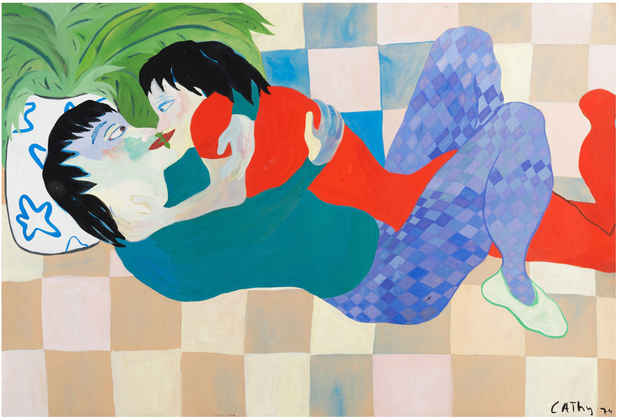Cathy Josefowitz “Forever Young”
Hauser & Wirth

This event has ended.
Hauser & Wirth New York presents ‘Forever Young,’ its first exhibition devoted to the art of Cathy Josefowitz (1956 – 2014). This focused presentation, occupying two floors of the gallery’s 69th Street location, celebrates Josefowitz’s life, vision and achievements through a meticulous selection of works, including many on view for the first time. Featuring a series of paintings, works on paper—including pastel, felt- tip pen, ink, gouache and watercolor—and rare film footage from two choreographies, the exhibition spotlights the earliest works in Josefowitz’s practice and explores traces of these pivotal breakthroughs that persisted throughout her career.
Prolific, prescient and infinitely imaginative, yet under-recognized in her lifetime, Josefowitz ingeniously transcended hierarchies of medium and genre in pursuit of an artistic practice that spanned drawing, painting, theater and dance. Born in New York and raised in Switzerland, she created an oeuvre of marked ambition, developing a compelling, sui generis visual syntax in her quest to represent the human body as a vehicle for expressing individual experience. Discussing her practice, Josefowitz said, ‘It’s my voice, my breathing, my world. Sometimes an ideal world, sometimes a very harsh world.’
The exhibition opens with a group of paintings produced during the early 1970s when Josefowitz was living in Paris, where she moved to study at the École Nationale Supérieure des Beaux-Arts. Influenced by several major 20th-century artistic movements, from fauvism and expressionism to Der Blaue Reiter, these early paintings reveal the artist’s incipient desire to show intimacy expressed through the quotidian as well as the inspiration she drew from cherished memories of her family and childhood. In untitled portraits from this period, Josefowitz depicted subjects in a variety of poses accentuating their physical and internal presence alike, as well as their relationships with other bodies. In her c. 1974 portraits of a woman drinking from a glass and of a nude woman standing before a sink, and in her 1974 painting of two supine bodies in a lovers’ embrace, Josefowitz portrayed figures engaged in private moments and mundane daily activities that are infused with many of the everyday motifs that recall, and elevate, the prosaic yet foundational memories of her youth.
Anchoring the gallery’s first floor is film footage of Josefowitz’s first choreography, ‘Woodstock’ (1983). Having attended the renowned Dartington College of Arts in Devon, England from 1979 to 1983, where she studied with such masters of contemporary dance as Steve Paxton and Mary Fulkerson, Josefowitz sought to dismantle the conventional hierarchy that separated performance and painting at that time and reconcile these two mediums in her practice. On stage, the symbols and themes that punctuated Josefowitz’s pictorial work became the subject of her choreographies. ‘Woodstock’ brings to life her nostalgia for the Upstate New York house built by her grandparents, who fostered an accepting and loving community founded on their outgoing personalities and vibrant, inclusive social life. In her choreography, Josefowitz embodied the ordinary acts and gestures of her childhood—the daily ritual of setting the table and eating breakfast, for instance—and celebrated them so that they became sacred.
As the exhibition moves to the second floor, viewers are exposed to the drawings that allowed Josefowitz, in even more immediate terms than painting, to realize the physical possibilities of the body. A selection of works on paper demonstrate how the artist used pastels to represent sensation through raw, unvarnished and increasingly distorted figures, capturing the body in both its anatomical and metaphysical dimensions. Executed on the pages of small notebooks that she always carried, these drawings exhibit the characteristic warping and exaggeration of her subjects’ anatomy, permitting her to convey the tenderness of an embrace or a figure’s exaggerated gesture and gaze more fully. The artist’s voraciousness in depicting the body in all its different configurations is evidenced by the quantity of drawings she produced, as she regularly sketched, not only in notebooks, but also on tablecloths, napkins, receipts, invoices and postcards, amassing a travelogue of the cities she visited.
Documenting the ways in which Josefowitz’s practice would later blur the lines between painting and dance, the exhibition presents footage of her choreographic work ‘For Ever Young’ (1989). Made in tribute following the tragic death of a friend and colleague, the piece is a study of movement and weightlessness, as the artist and her dancing partner revolve around a chair to the point at which the piece of furniture becomes an extension of her body, their motion conveying an impression of endlessly falling. Having said that ‘I love the human body, it fascinates me to move it, to be moved; more than that, it’s like a love affair that I feel in dance and in painting,’ Josefowitz also began her painting sessions with a dance as her practice moved further into abstraction and the exploration of space on both the stage and the canvas, which in turn resulted in the gradual disappearance of the body from her oeuvre. This evolution is evident in such oil paintings as ‘Triptyque bleu blanc rouge’ (1994) that depict eerily anthropomorphic chairs, a direct reference to ‘For Ever Young,’ in which she captured the body in motion, fading—or falling away—into the canvas, in a single abstracted image.
Finally, her Kamasutra paintings from 2009 and 2010—inspired by the Indian mystic Osho, whose teachings promoted the celebration of life—show couples having sex while also minimizing the human body to such a degree that it is hardly discernible against the limitless, monochromatic space surrounding the figures. With this focus on shading, geometry and ambiguous settings, Josefowitz would in the last years of her life use these elements to evoke the same emotional resonance of the spirit that she had, until this point, used the body itself to summon. In the last paintings that the artist produced, the figure disappeared from her oeuvre entirely, giving way to a total abstraction that liberated the artist in her quest to dispense with limits and restrictions.
Media
Schedule
from May 11, 2023 to July 22, 2023